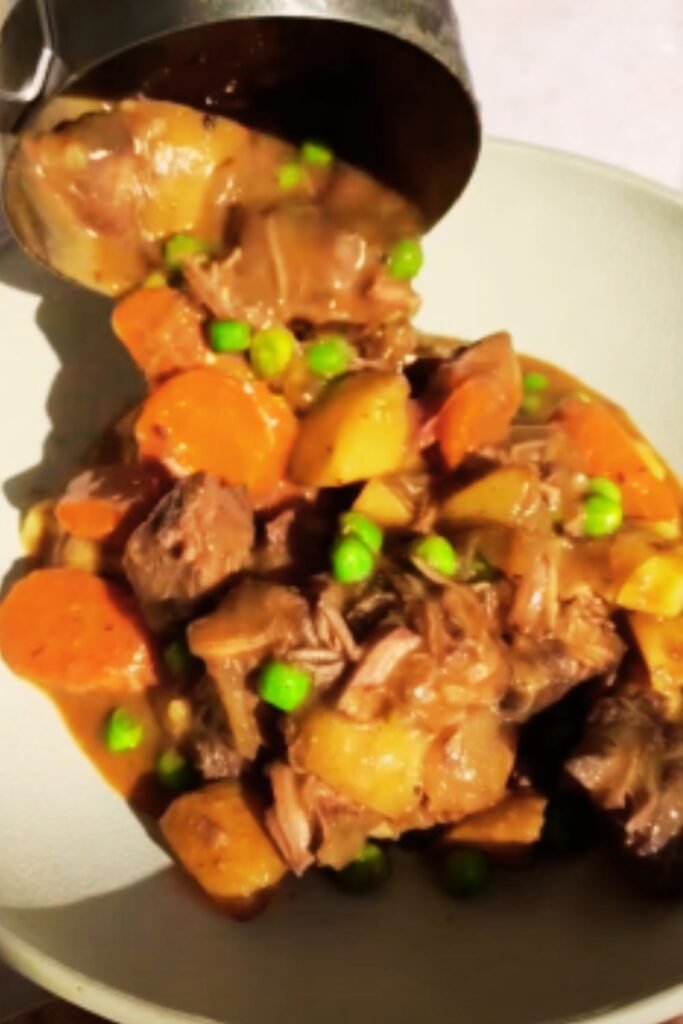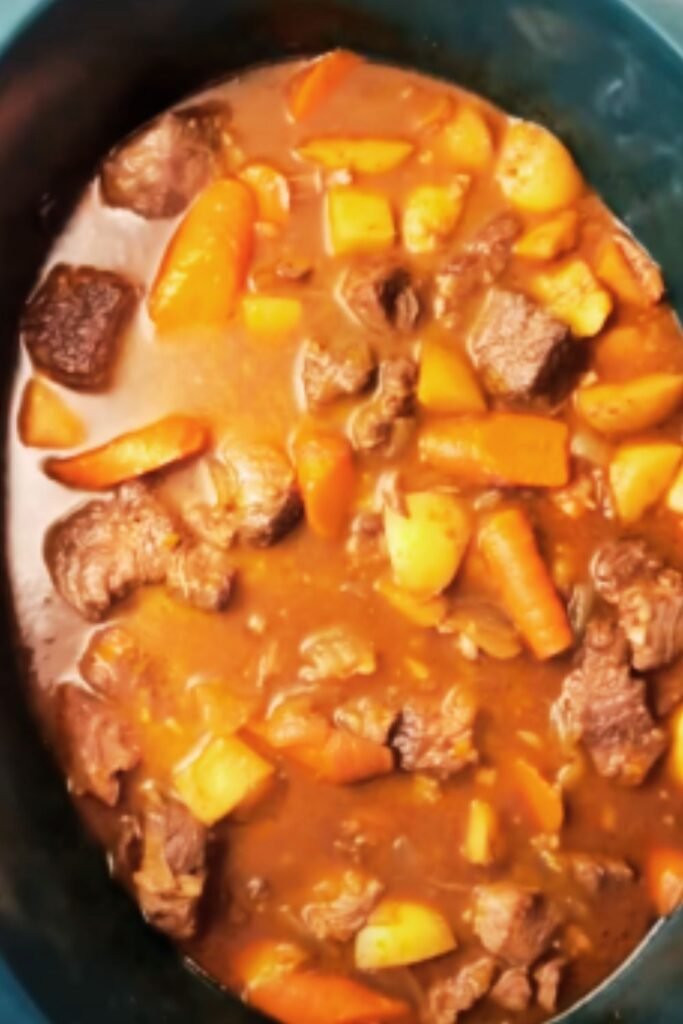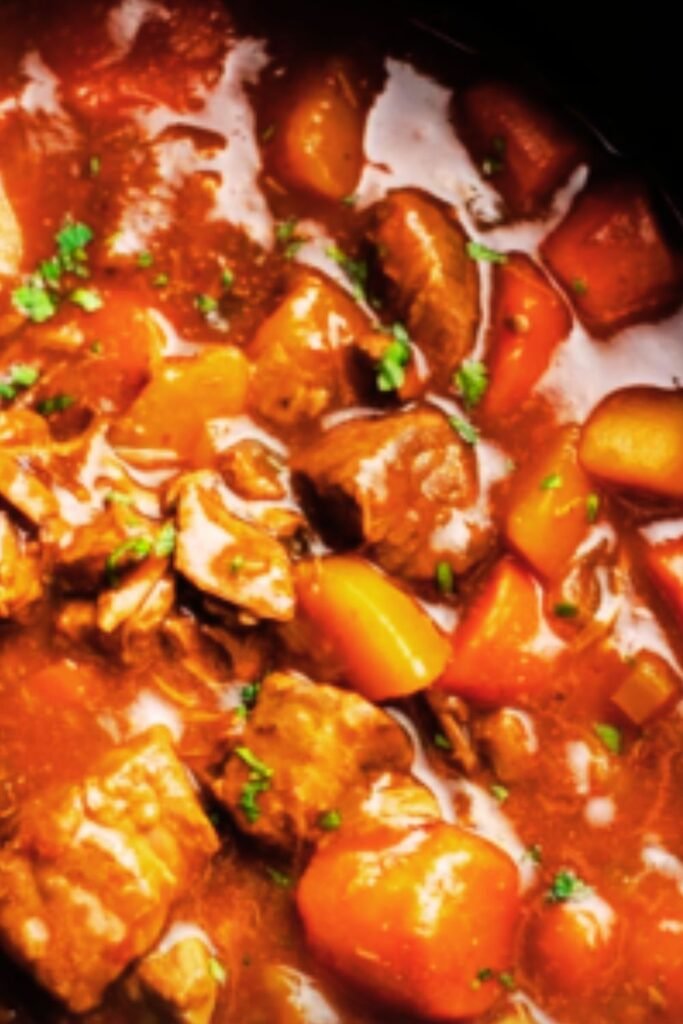There’s something magical about walking into your home after a long day and being greeted by the rich, savory aroma of beef stew that’s been simmering away in your slow cooker. I’ve been perfecting my slow cooker beef stew recipe for years, and I’m excited to share my ultimate version with you today. This hearty, comforting meal requires minimal hands-on time but delivers maximum flavor—the essence of what makes slow cooking so wonderful.
What Makes This Beef Stew Special
My slow cooker beef stew isn’t just another recipe—it’s the culmination of years of testing and tweaking. The meat becomes fork-tender, the vegetables maintain their texture without turning to mush, and the broth transforms into a rich, flavorful gravy that will have you reaching for bread to soak up every last drop.
What truly sets this recipe apart is the careful balance of browning the meat first (yes, it’s worth the extra step!), my special blend of herbs, and a few unexpected ingredients that elevate the flavor profile from good to exceptional. Let me walk you through creating this soul-warming meal that’s perfect for chilly evenings, Sunday family dinners, or whenever you crave something deeply satisfying.
Ingredients You’ll Need
For the Beef and Marinade:
- 2½ pounds beef chuck roast, cut into 1½-inch cubes
- 3 tablespoons olive oil, divided
- 1 tablespoon Worcestershire sauce
- 2 cloves garlic, minced
- 1 teaspoon salt
- ½ teaspoon freshly ground black pepper
For the Stew Base:
- 1 large yellow onion, diced
- 3 celery stalks, chopped
- 4 cloves garlic, minced
- 2 tablespoons tomato paste
- ¼ cup all-purpose flour
- 1 cup dry red wine (optional, can substitute beef broth)
- 4 cups beef broth (low sodium preferred)
- 2 tablespoons Worcestershire sauce
- 2 bay leaves
- 1 teaspoon dried thyme
- 1 teaspoon dried rosemary
- ½ teaspoon dried oregano
- 2 tablespoons fresh parsley, chopped (plus more for garnish)
For the Vegetables:
- 4 medium carrots, peeled and cut into 1-inch chunks
- 1 pound baby potatoes, halved (or regular potatoes cut into 1½-inch pieces)
- 8 ounces mushrooms, quartered
- 1 cup frozen peas (to be added during the last 30 minutes)
Essential Equipment
- 6-quart slow cooker (or larger)
- Large skillet or Dutch oven for browning
- Sharp knife and cutting board
- Measuring cups and spoons
Detailed Instructions
Step 1: Prepare and Marinate the Beef
I always start by trimming excess fat from the beef chuck roast and cutting it into uniform 1½-inch cubes. This size is perfect—large enough to maintain juiciness during long cooking, but small enough to become tender. In a large bowl, I toss the beef cubes with 1 tablespoon olive oil, 1 tablespoon Worcestershire sauce, minced garlic, salt, and pepper. If I have time, I let this marinate for 30 minutes (or even overnight in the refrigerator), but it’s still delicious if you need to proceed immediately.
Step 2: Brown the Beef (Don’t Skip This!)
In my experience, this step makes the difference between a good stew and an exceptional one. Heat 1 tablespoon olive oil in a large skillet over medium-high heat. Working in batches (usually 2-3 depending on your skillet size), brown the beef on all sides. I’m careful not to overcrowd the pan—about 2-3 minutes per side is perfect. This creates a beautiful crust that seals in juices and develops deep flavor compounds that will enrich your stew. Transfer the browned beef to your slow cooker.
Step 3: Create the Flavor Base
In the same skillet with all those beautiful browned bits, I add the remaining tablespoon of olive oil and sauté the diced onion and celery until softened (about 4-5 minutes). Then I add the minced garlic and cook for another 30 seconds until fragrant. Next comes the tomato paste—I stir it in and cook for about 1 minute to caramelize slightly and remove the raw taste.
Now for a crucial step: I sprinkle the flour over the vegetable mixture and stir constantly for 1-2 minutes. This will help thicken our stew without lumps. Slowly add the wine (if using), scraping the bottom of the pan to release all those flavorful browned bits. Let this simmer for 1-2 minutes to cook off some of the alcohol and concentrate the flavor.
Step 4: Combine Everything in the Slow Cooker
I transfer this vegetable mixture to the slow cooker containing the browned beef. Then I add the beef broth, additional Worcestershire sauce, bay leaves, and dried herbs. I stir well to combine all the ingredients.
Now I add the carrots, potatoes, and mushrooms, pushing them down slightly into the liquid. The vegetables shouldn’t be completely submerged—this placement allows them to steam and maintain their texture rather than becoming overly soft.
Step 5: Set It and (Almost) Forget It
Cover the slow cooker and set it to cook on LOW for 7-8 hours or HIGH for 4-5 hours. The low and slow approach is my preference for the most tender beef, but both methods yield delicious results. About 30 minutes before the cooking time is complete, I stir in the frozen peas. This late addition keeps them bright green and pleasantly firm.
Step 6: Final Touches
Once the cooking time is complete, I remove the bay leaves and taste the stew, adjusting the seasoning with additional salt and pepper if needed. If I want a thicker gravy, I sometimes create a slurry by mixing 1 tablespoon cornstarch with 2 tablespoons cold water and stirring it into the stew. I then cover and cook on HIGH for an additional 15 minutes until thickened.
Just before serving, I sprinkle fresh chopped parsley over the top for a burst of color and fresh flavor.

The Science Behind Perfect Slow Cooker Beef Stew
I’ve always been fascinated by the transformation that happens in the slow cooker. Here’s what makes this cooking method so effective for beef stew:
Collagen Breakdown
Chuck roast is rich in collagen—a tough connective tissue that breaks down into gelatin during low, slow cooking. This process, which begins around 160°F (71°C) and continues throughout the cooking time, is what makes the meat incredibly tender and gives the broth its rich, silky texture.
Maillard Reaction
By browning the meat before adding it to the slow cooker, we trigger the Maillard reaction—a chemical process that creates hundreds of new flavor compounds. This is why that initial browning step is so crucial for depth of flavor.
Aromatic Infusion
The long cooking time allows the herbs and aromatics to fully infuse into both the broth and the meat, creating layers of flavor that simply can’t be rushed.
Nutritional Information
I believe in knowing what’s in your food, so here’s a breakdown of the approximate nutritional content per serving (based on 8 servings):
| Nutrient | Amount per Serving |
|---|---|
| Calories | 420 |
| Protein | 38g |
| Carbohydrates | 25g |
| Dietary Fiber | 4g |
| Sugars | 5g |
| Fat | 18g |
| Saturated Fat | 6g |
| Cholesterol | 95mg |
| Sodium | 720mg |
| Potassium | 1120mg |
| Iron | 4.5mg |
| Vitamin A | 3500 IU |
| Vitamin C | 18mg |
Helpful Tips for Success
After making this stew countless times, I’ve learned some tricks that make a huge difference:
- Choose the right cut: Chuck roast is ideal because it has the perfect amount of fat and connective tissue that breaks down during slow cooking.
- Uniform cutting: Try to cut meat and vegetables into similar-sized pieces for even cooking.
- Don’t skip the browning: This extra step adds tremendous depth of flavor.
- Layer strategically: Place the meat on the bottom where it will be surrounded by liquid, with vegetables arranged on top.
- Keep the lid on: Every time you peek, you add 15-20 minutes to the cooking time as heat escapes.
- Add acid: The wine and Worcestershire sauce add brightness that balances the rich flavors.
- Finish with freshness: Adding peas at the end and garnishing with fresh herbs brings vibrancy to the dish.

Variations to Try
While my classic version above is my go-to, I love experimenting with these variations:
Root Vegetable Medley
Substitute parsnips, turnips, or sweet potatoes for some or all of the regular potatoes for added complexity and nutritional variety.
Herbes de Provence
Replace the individual dried herbs with 1½ teaspoons of Herbes de Provence for a French-inspired flavor profile.
Guinness Beef Stew
Replace the wine with Guinness stout for a deeper, maltier flavor that pairs beautifully with beef.
Hungarian-Style
Add 1 tablespoon paprika (preferably Hungarian) and a dollop of sour cream stirred in just before serving for a delicious twist.
Harvest Beef Stew
Add 1 diced apple and ¼ cup dried cranberries in the last hour of cooking for a subtle sweetness that complements the savory components.
Make-Ahead and Storage Tips
One of the best things about this stew is how well it keeps and how the flavors continue to develop over time:
Make-Ahead Options:
- Prep ingredients: Cut all meat and vegetables up to 24 hours in advance and store separately in the refrigerator.
- Complete and refrigerate: Make the entire stew, cool completely, and refrigerate for up to 3 days. The flavors will actually improve!
- Freezer meal: After cooling completely, freeze in airtight containers for up to 3 months. Thaw overnight in the refrigerator before reheating.
Reheating:
- Stovetop: Reheat gently over medium-low heat, stirring occasionally and adding a splash of broth if needed to loosen.
- Microwave: Use 50% power and stir every minute until heated through to avoid overheating the meat.
- Slow cooker: Reheat on LOW for 1-2 hours until warmed through.
Serving Suggestions
To create a complete meal experience, I recommend serving this hearty beef stew with:
- Crusty artisan bread, dinner rolls, or biscuits for sopping up the delicious gravy
- A simple green salad with a light vinaigrette to balance the richness
- Steamed green beans or roasted Brussels sprouts for additional vegetables
- Cranberry sauce for a sweet-tart contrast
- A dollop of sour cream or Greek yogurt on top for creaminess

Troubleshooting Common Issues
Even experienced cooks encounter challenges. Here are solutions to common beef stew problems:
| Problem | Possible Cause | Solution |
|---|---|---|
| Tough meat | Insufficient cooking time | Continue cooking 30-60 minutes longer; check a piece of meat for tenderness |
| Watery stew | Too much liquid or not enough thickening | Create a cornstarch slurry (1 Tbsp cornstarch + 2 Tbsp cold water) and add during the last 30 minutes on HIGH |
| Bland flavor | Insufficient seasoning or browning | Add more Worcestershire sauce, a splash of balsamic vinegar, or additional herbs; adjust salt and pepper |
| Mushy vegetables | Added too early or cut too small | Cut vegetables larger next time or add root vegetables halfway through cooking time |
| Flour lumps | Flour added directly to liquid | Always mix flour with fat first or create a smooth slurry with cold liquid before adding |
| Greasy surface | Excess fat in meat or not trimmed properly | Refrigerate the stew, remove hardened fat from surface, then reheat |
Frequently Asked Questions
Here’s a collection of the questions I’m most often asked about making beef stew:
Q: Can I put the meat in the slow cooker without browning it first? While you can technically skip this step, I strongly recommend against it. The browning creates depth of flavor that’s impossible to achieve otherwise. If you’re pressed for time, just brown half the meat—even that will make a noticeable difference.
Q: What can I substitute for the wine? You can simply use additional beef broth with a tablespoon of red wine vinegar or balsamic vinegar to add acidity and depth.
Q: My slow cooker runs hot. Should I adjust the cooking time? Yes! If you notice your slow cooker tends to cook things faster than recipes suggest, check the stew after 5-6 hours on LOW or 3-4 hours on HIGH. The meat should be fork-tender but not falling apart completely.
Q: Can I add different vegetables? Absolutely! Just be mindful of cooking times. Dense root vegetables can go in at the beginning, while quicker-cooking vegetables like bell peppers or zucchini should be added during the last hour.
Q: How do I make this beef stew in a pressure cooker or Instant Pot? Brown the meat and sauté the vegetables using the sauté function. Add remaining ingredients (except peas), seal, and cook on high pressure for 35 minutes with a 10-minute natural release. Add peas after pressure cooking and allow to heat through for 2-3 minutes.
Q: Can I double this recipe? Yes, if your slow cooker is large enough (8 quarts or larger). Cooking time remains the same, but you may need to brown the meat in more batches.
Final Thoughts
Making a truly exceptional beef stew isn’t about fancy techniques or exotic ingredients—it’s about understanding the fundamentals of flavor development and having the patience to let time work its magic. This slow cooker beef stew has been my go-to comfort food for years, earning its place as a family favorite and requested recipe among friends.
What makes it special is the balance of rich savory notes, subtle herbal undertones, and the incredible texture of tender beef alongside perfectly cooked vegetables. Even better, it’s practical for busy households—minimal active cooking time with maximum reward.
I hope you’ll try this recipe the next time you’re craving something deeply satisfying and nourishing. And don’t be surprised if the aroma filling your home brings everyone to the kitchen asking, “When will dinner be ready?”
Remember, the best stews are made with love and a little patience. Happy cooking!


